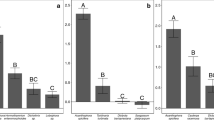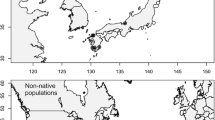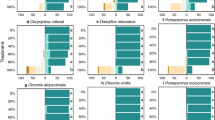Abstract
Sea hares are a rich source of novel secondary metabolites, most of which are derived from their algal diet, but the natural function(s) of these metabolites are largely unknown. We used field and laboratory assays to measure the palatability of extracts from the tissues, ink, and eggs of Dolabella auricularia. Digestive-gland extracts contained a wide variety of secondary metabolites, including the red algal compound prepacifinol epoxide and its derivative johnstonol, and they were unpalatable to reef fishes. Skin extracts were moderately unpalatable, but our bioassay-guided fractionation led us to (–)-7-dehydrocholesterol, rather than to an algal secondary metabolite. Ink extracts were consistently unpalatable to reef fishes only at high concentrations, suggesting either that ink must be concentrated to deter predators, that unpalatable components of ink rapidly decompose, or that ink has other functions. Unpalatability of ink was traced to a purple fraction, consistent with the hypothesis that the active compound is aplysioviolin, a known ink constituent modified from a red algal pigment. Egg extracts were moderately unpalatable; however, we could not trace this activity to any algal-derived secondary metabolite. Body-wall extract was highly palatable. Our results suggest that dietary-derived secondary metabolites play a role in chemical defense of D. auricularia via the ink, but are not responsible for unpalatability of skin or eggs. Accumulation of dietary-derived metabolites in the digestive gland may occur to detoxify a chemically rich diet, rather than or in addition to deterring predators.
Similar content being viewed by others
REFERENCES
Ambrose, H. W., III, and Givens, R. P. 1979. Distastefulness as a defense mechanism in Aplysia brasiliana (Mollusca: Gastropoda). Mar. Behav. Physiol. 6:57–64.
Avila, C. 1995. Natural products of opisthobranch molluscs: A biological review. Oceanogr. Mar. Biol. Annu. Rev. 33:487–559.
Bobzin, S. C., and Faulkner, J. D. 1992. Chemistry and chemical ecology of the Bahamian sponge Aplysilla glacialis. J. Chem. Ecol. 18:309–332.
Carefoot, T. H. 1987. Aplysia: Its biology and ecology. Oceanogr. Mar. Biol. Annu. Rev. 25:167–284.
Careffoot, T. H., Harris, M., Taylor, B. E., Donovan, D., and Karentz, D. 1998. Mycosporine-like amino acids: Possible UV protection in eggs of the sea hare Aplysia dactylomela. Mar. Biol. 130:389–396.
Carefoot, T. H., Pennings, S. C., and Danko, J. P. 1999. A test of novel function(s) for the ink of sea hares. J. Exp. Mar. Biol. Ecol. 234:185–197.
Chapman, D. J., and Fox, D. L., 1969. Bile pigment metabolism in the sea-hare Aplysia. J. Exp. Mar. Biol. Ecol. 4:71–78.
de Nns, R., Steinberg, P. D., Rogers, C. N., Charlton, T. S., and Duncan, M. W. 1996. Quantitative variation of secondary metabolites in the sea hare Aplysia parvula and its host plant, Delisea pulchra. Mar. Ecol. Prog. Ser. 130:135–146.
DiMatteo, T. 1981. The inking behavior of Aplysia dactylomela (Gastropoda: Opisthobranchia): Evidence for distatefulness. Mar. Behav. Physiol. 7:285–290.
DiMatteo, T. 1982. The ink of Aplysia dactylomela (Rang, 1828) (Gastropoda: Opisthobranchia) and its role as a defense mechanism. J. Exp. Mar. Biol. Ecol. 57:169–180.
Faulkner, D. J. 1984. Marine natural products: Metabolites of marine algae and herbivorous marine molluscs. Nat. Prod. Rep. 1:251–280.
Faulkner, D. J. 1988. Feeding deterrents in molluscs, pp. 29–36, in D. G. Fautin (ed.). Biomedical Importance of Marine Organisms. California Academy of Sciences, San Francisco.
Faulkner, D. J. 1992. Chemical defenses of marine molluscs, pp. 119–163 in V. J. Paul (ed.). Ecological Roles of Marine Natural Products. Comstock Publishing Associates, Ithaca, New York.
Faulkner, D. J. 1997. Marine natural products. Nat. Prod. Rep. 14:259–302.
Faulkner, D. J., Stallard, M. O., and Ireland, C. 1974. Prepacifenol epoxide: a halogenated sesquiterpene diepoxide. Tetrahedron Lett. 40:3571–3574.
Flury, F. 1915. Uber das Apysiengift. Arch. Exp. Pathol. Pharmakol. 79:250–263.
Gunatilaka, A. A. L., Gopichand, Y., Schmitz, F. J., and Dierassi, C. 1981. Minor and trace sterols in marine invertebrates. 26. Isolation and structure elucidation of nine new 5α,8α-epidioxy sterols from four marine organisms. J. Org. Chem. 46:3860–3866.
Ireland, C., Stallard, M. O., Faulkner, D. J., Finer, J., and Clardy, J. 1976. Some chemical constituents of the digestive gland of the sea hare Aplysia californica. J. Org. Chem. 41:2461–2465.
Kamiya, H., Muramoto, K., and Ogata, K. 1984. Antibacterial activity in the egg mass of a sea hare. Experientia 40:947–949.
Myers, R. F. 1989. Micronesian Reef Fishes. Coral Graphics, Guam.
Nolen, T. G., Johnson, P. M., Kicklighter, C. E., and Capo, T. 1995. Ink secretion by the marine snail Aplysia californica enhances its ability to escape from a natural predator. J. Comp. Physiol. A 176:239–254.
Ortega, M. J., ZubÍa, E., and SalvÁ, J. 1997. 3-epi-Aplykurodinone B, a new degraded sterol from Aplysia fasciata. J. Nat. Prod. 60:488–489.
Paul, V. J., and Pennings, S. C. 1991. Diet-derived chemical defenses in the sea hare Stylocheilus longicauda (Quoy et Gaimard, 1824). J. Exp. Mar. Biol. Ecol. 151:227–243.
Pennings, S. C. 1990. Multiple factors promoting narrow host range in the sea hare, Aplysia californica. Oecologia 82:192–200.
Pennings, S. C. 1994. Interspecific variation in chemical defenses in the sea hares (Opisthobranchia: Anaspidea). J. Exp. Mar. Biol. Ecol. 180:203–219.
Pennings, S. C., and Paul, V. J. 1992. Effect of plant toughness, calcification, and chemistry on herbivory by Dolabella auricularia. Ecology 73:1606–1619.
Pennings, S. C., and Paul, V. J. 1993. Sequestration of dietary secondary metabolites by three species of sea hares: Location, specificity and dynamics. Mar. Biol. 117:535–546.
Pennings, S. C., Nadeau, M. T., and Paul, V. J. 1993. Selectivity and growth of the generalist herbivore Dolabella auricularia feeding upon complementary resources. Ecology 74:879–890.
Peterson, C. H., and Renaud, P. E. 1989. Analysis of feeding preference experiments. Oecologia 80:82–86.
Pettit, G. R. 1996. Progress in the discovery of biosynthetic anticancer drugs. J. Nat. Prod. 59:812–821.
Pettit, G. R., Kamano, Y., Kizu, H., Dufresne, C., Herald, C. L., Bontems, R. J., Schmidt, J. M., Boettner, F. E., and Nieman, R. A. 1989. Isolation and structure of the cell growth inhibitory depsipeptides dolastains 11 and 12. Heterocycles 28:553–558.
Sims, J. J., Fenical, W., Wing, R. M., and Radlick, P. 1972. Marine Natural Products III. Johnstonol; an unusual halogenated epoxide from Laurencia johnstonii. Tetrahedron Lett. 3:195–198.
Slattery, M., Hamann, M. T., McClintock, J. B., Perry, T. L., Puglisi, M. P., and Yoshida, W. Y. 1997. Ecological roles for water-borne metabolites from Antarctic soft corals. Mar. Ecol. Prog. Ser. 161:133–144.
Stallard, M. O., and Faulkner, D. J. 1974. Chemical constituents of the digestive gland of the sea hare Aplysia californica—I. Importance of diet. Comp. Biochem. Physiol. 49B:25–35.
Switzer-Dunlap, M., and Hadfield, M. G. 1977. Observations on development, larval growth and metamorphosis of four species of aplysiidae (Gastropoda: Opisthobranchia) in laboratory culture. J. Exp. Mar. Biol. Ecol. 29:245–261.
Switzer-Dunlap, M., and Hadfield, M. G. 1979. Reproductive patterns of Hawaiian aplysiid gastropods. pp. 199–210 in S. E. Stancyk (ed.). Reproductive Ecology of Marine Invertebrates, University of South Carolina Press, Colombia.
Winkler, L. R. 1969. Distribution of organic bromide compounds in Aplysia californica Cooper, 1863. Veliger 11:268–271.
Yamada, K., and Kigoshi, H. 1997. Bioactive compounds from the sea hares of two genera: Aplysia and Dolabella. Bull. Chem. Soc. Jpn. 70:1479–1489.
Author information
Authors and Affiliations
Rights and permissions
About this article
Cite this article
Pennings, S.C., Paul, V.J., Dunbar, D.C. et al. Unpalatable Compounds in the Marine Gastropod Dolabella auricularia: Distribution and Effect of Diet. J Chem Ecol 25, 735–755 (1999). https://doi.org/10.1023/A:1020832414766
Issue Date:
DOI: https://doi.org/10.1023/A:1020832414766




